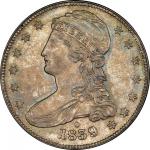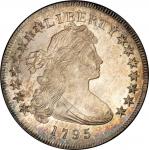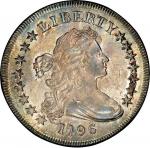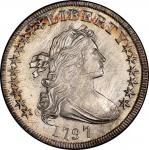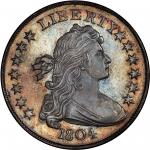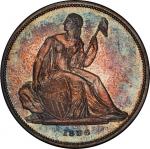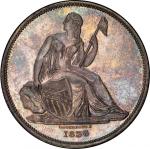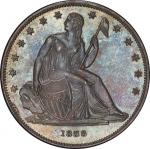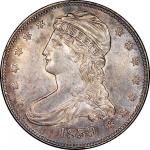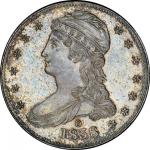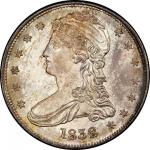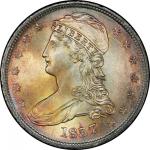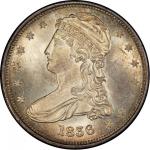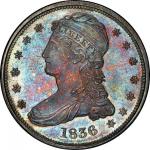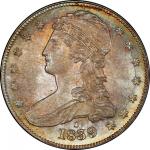The O, under the bust, is the mint-mark of the New Orleans Branch Mint.” — J.L Riddell, The Monograph of the Silver Dollar, Good and Bad, 1845</em>The finest New Orleans Mint production of this design type ever certified by PCGS, this example is abundantly bathed in opalescent toning and frosty luster, lending both sides unique aesthetic appeal. Thin rings of rich gold and translucent blue frame the obverse, while the centers blend silvery tones with orange and violet highlights into a beautiful but difficult to describe melange. The reverse combines many of the same tones, though in lighter proportions, surrounded by rims dominated by champagne. Exceptional cartwheel luster highlights the most subtle tones and brings them to life. The obverse strike is very good, even as some modest softness is seen on Liberty’s cap and stars 1 through 3 lack complete centers. Softness manifests more obviously on the reverse, where D S of UNITED STATES and the tops of DOL find themselves in the unenviable position of being opposite the areas of the obverse’s highest relief. The branch end and talon at right likewise lack some detail.Both sides are impressively close to immaculate, with no major marks or lines seen on either obverse or reverse. A couple very short lines may be discerned low on Liberty’s cheek, in proper light and with concentrated scrutiny, and a single mark is present in the right field close to the base of her cap. The high rim that surrounds much of the obverse is perfect. Clearly, this coin has been cherished since essentially the moment it was struck. The dies it was struck from were not as perfect, however, and both sides show extensive cracks around their peripheries. An impressive arc connects all the stars, starting weakly at stars 1 and 2 but bold from stars 3 to 6, across Liberty’s cap, and through stars 7 to 12. Divisions from that crack turn one way to join the rim from star 12 and another way to cross the lowest curl. From the curl, the crack divides again, doubling back to meet star 13 and crossing all four date digits near their midpoints before curling up into the drapery. The reverse die is shattered, with cracks extending under UNIT to the bases of ED, from the rim through A of STATES and across the eagle’s beak below, joining the bases of TES OF AME, arcing from the rim above E through ERIC and back to the rim, from I to the wing and from the bases of CA to the arrowhead below, and through a network that connects the leftmost leaf cluster to the nearby wingtip and U of UNITED above and crosses HALF DOL to the arrowheads beyond. Every letter and every peripheral design element of the reverse is connected to fine die cracks. It is a wonder this die could produce a coin with so much detail.This issue was first described in print six years after its production, in a work on counterfeit detection by Dr. John L. Riddell, the melter and refiner of the New Orleans Mint. Appointed to a position at the Mint at the end of 1839, Riddell wrote and illustrated <em>A Monograph of the Silver Dollar,</em> Good and Bad from the deposits that arrived daily at the New Orleans Mint. An inventor, a chemistry professor, and an adventurer, Riddell’s creativity and skill were put to use in his production of “metal types adapted for printing, indirectly from the coins themselves.” By casting the coins he found into printing blocks made of type metal, the illustrations in Riddell’s work are still detailed enough to be useful to numismatists 170 years later. While Riddell illustrated no genuine New Orleans Mint half dollars of this type, neither this date nor its rare predecessor, by 1845 he had already encountered three different varieties of counterfeit 1839-O half dollars. Two of the counterfeits were crudely struck from handmade dies, while the other was cast from a genuine coin in “an alloy like type metal with copper,” similar to what is called German silver today.This coin has survived with not only detail, but every other positive characteristic a coin could retain: originality, luster, aesthetic appeal, superb technical grade, and more. Its provenance includes three collections whose names are synonymous with superb quality: Knoxville, Jung, and Pogue. This coin stands alone as the finest example ever graded by PCGS.PCGS# 6181. NGC ID: 24G7.

